
James T. Gardiner

Charles F. Hoffmann
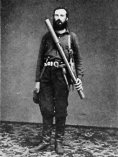
William H. Brewer
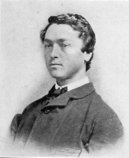
Richard D. Cotter
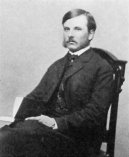
Clarence King
| Online Library: | Title | Author | California | Geology | History | Indians | Muir | Mountaineering | Nature | Management |
Yosemite > Library > Up & Down Calif. > 1864 Chapter 1 >
| Next: Chapter 2 • Contents • Previous: Book 4 |
BOOK V
1864
Off for the Field Again—Pacheco’s Pass—A Reunion—San Luis de Gonzaga Ranch—Drought—The San Joaquin Valley—Mirage and Whirlwind—The Passing of Jim—Visalia—Foothills—Thomas’ Mill—Sequoias—Two Giants.
Pacheco Pass.
May 29, 1864.1
The party consists of Hoffmann, King, Gardner, and Dick. The first two have been with me much before. Gardner is a very nice young man, an engineer. He and King give their time, the Survey paying only their traveling expenses in return for their time and labor. Dick is a young man from Pike,2 who goes as packer, etc.—a very good fellow, but most unfortunately knows nothing about packing, so we have to teach him and I think that he will do well. Packing is an intricate art. To put a load of baggage on a mule and make it stay there, and at the same time not hurt the mule, is a great art. We have but two pack-mules, scarcely enough, to tell the truth.
We came on eighteen miles and stopped at Haywards that night, and were nearly devoured by mosquitoes. The next day we went on to San Jose, thirty-one miles. We stopped for noon at Warm Springs and, for the first time in this state, because of our camp shirts did not dine in the public dining room, but when it was ascertained who we were there were very funny apologies.
At San Jose I called on Mr. Hamilton. His congregation is building a fine church, but the earthquake a few days ago frightened them much. I met there Mrs. Mead, Mrs. Hamilton’s mother. She looked scarcely older than when I had seen her last, nine years ago, in Maine.
May 27 we came on up the San Jose Valley, twenty-one miles. The day was intensely hot, 97°, the air scorching and dusty. The drought is terrible. In this fertile valley there will not be over a quarter crop, and during the past four days’ ride we have seen dead cattle by the hundreds. The hot air trembled over the plain, and occasionally a mirage seemed to promise cool weather ahead, only to vanish as we approached. The mountains on either side were bathed in a haze and seemed all tremulous in the heated air.
We got to the 21-Mile House and camped under the old oak trees. We had camped there before, once in ‘61, and again in ‘62. The spot seemed familiar and awoke pleasing memories, and that night, on the ground under the trees, sweeter sleep came than had for many a long night before.
Yesterday we came on here, thirty miles farther. We followed south to Gilroy, then struck east and entered the pass, and are now camped under the same tree that we camped under two years ago when we came through the same pass. The hills are terribly dry, totally bare of forage, parched and brown. The scattered oaks, evergreen, seem dark—they are so tenacious of life that the drought fails to kill them. It must be a terrible year for the thousands of sheep that are kept here. A hot wind sweeps up the canyon in which we are camped. It is 92°, and the air intensely dry. It always draws through this gap in an almost ceaseless current—the trees and bushes are

James T. Gardiner |

Charles F. Hoffmann |
|

William H. Brewer |
||

Richard D. Cotter |

Clarence King |
|
A little event occurred this morning, so characteristic of California that I must relate it. A traveler stopped at the house last night, tall, swarthy, heavily bearded. As I stood by this morning, along came another, with gun on his shoulder, knife in his belt. A heavy beard covered his face; his dress, his whole look told of a rough life. He eyed the stranger a minute. Then ensued the following conversation, and much more of the same sort—only the names and strong oaths I leave out:
B. “Is your name Smith?”
S. “Yes.”
B. “Why, how do you flourish? My name is Brown—don’t you know me?”
S. “No.”
B. “Why, d—n it, we were together at — in Mexico, in ‘47.”
S. “By G—d, that’s so, but I didn’t know you—you’ve changed.”
B. “Certainly—I was a boy then but seventeen years old.”
S. “And I but eighteen. How did you escape?”
B. “By G—d, the d—n greasers couldn’t keep me.”
S. “Where do you live?”
B. “Up here in the mountains.”
S. “How long you been here?”
B. “Since ’49. Where do you live?”
S. “By G—d, nowhere, and I have been almost everywhere since I saw you.”
B. “To the States?”
S. “Yes, half a dozen times.”
B. “Where’s the old man?”
S. “Father?”
B. “Yes.”
S. “In old Arkansaw, fighting Yankees I suppose. Have you seen any of the other boys?”
B. “Yes, lots of ‘em. You remember Bob?”
S. “G—d, yes, don’t I—where’s he?”
B. “Gone to Idaho, saw him last winter. They call him ‘Cherokee Bob’ here—you know he is very dark.”
S. “He ain’t no Cherokee, he’s a regular white man.”
B. “Yes, but since he killed that feller in Stockton he has gone by the name of Cherokee Bob.”
S. “Has he been back?” (Meaning East.)
B. “Yes, but he killed a man in Missouri and had to leave again. He’s killed four in this state but always got off. He’s a d—d lucky fellow.”
S. “Where’s Bill?”
B. “Dead. Killed about four year ago. There’s Dick, too, he got shot in Utah.”
S. “Where’s —, that tall feller, you know?”
B. “Oh, he’s in this state, a shiftless cuss. Been mining, but ain’t worth a cent.”
S. “D—n me, it does me good to see an old friend. I hain’t seen one of those old boys afore since I came here fifteen year ago. I left here soon. Let’s drink.”
The two imbibe and recall old reminiscences, and each goes on his way. Much of the converstation, of course, I don’t report, only a part of it. But the whole thing was so Californian that I had to tell it. They had been fellow prisoners, taken by the Mexicans in the Mexican War.
Under a Tree, Tulare Plain.
Sunday, June 5.
Monday, May 30, we came on to San Luis de Gonzaga Ranch, at the eastern entrance of the pass. Our road lay over the mountains. They are perfectly dry and barren, no grass—here and there a poor gaunt cow is seen, but what she gets to eat is very mysterious.
As we cross the summit the Sierra Nevada should be in view, with its sharp outline and cool snows; but not so—we look out on the dry plain, which becomes more indistinct and finally fades away into the hazy air, shutting out like a veil all that lies beyond. The wind blows heavily over the pass, and we descend to the San Luis Ranch. The wind is so high that we can build no fire, so we cook in the dirty kitchen. Dust fills the air—often we cannot see fifty yards in any direction—it covers everything. We cook our dinner, but before it can be eaten we cannot tell its color because of the dirt that settles on it. Our food is gritty between our teeth, and as we drink out our cups of tea we find a deposit of fine sand in the bottom. Dirt, dirt, dirt—eyes full, face dirty, whole person feeling dirty and gritty.
All around the house it looks desolate. Where there were green pastures when we camped here two years ago, now all is dry, dusty, bare ground. Three hundred cattle have died by the miserable water hole back of the house, where we get water to drink, and their stench pollutes the air.
This ranch contains eleven square leagues, or over seventy-six square miles. In its better days it had ten thousand head of cattle, besides the horses needed to manage them. Later it became a sheep ranch, and two years ago, when we camped here, it fed sixteen thousand sheep besides some few thousand cattle. Now, owing to the drought, there is no feed for cattle, and not over one thousand sheep, if that, can be kept through the summer. The last of the cattle, about one thousand head, were lately sold for $1,500, or only $1.50 each! Such is the effect of the drought on one ranch.
We spent a miserable night there, the wind and dust almost preventing sleep, and paid fourteen dollars in gold for the hay that our seven animals ate.
May 31 we came on to Lone Willow, a stage station out on the plain, where there has been a sheep ranch until the present year. The ride was over the plain, which is utterly bare of herbage. No green thing greets the eye, and clouds of dust fill the air. Here and there are carcasses of cattle, but we see few living ones—not twenty during the day, where nearly as many thousands could have been seen two years ago. There is a sink hole of alkaline water, by which stands the “lone willow,” the only tree for many a weary mile. Our camp here is as dirty, dusty, and miserable as the last. There is a well that supplies water for drinking that is poorer than any you ever tasted, yet quite good for the region.
June 1 we came on to Firebaugh’s Ferry, on the San Joaquin, twenty-five miles. Portions of this day’s ride, for miles together, not a vestige of herbage of any kind covered the ground; in other places there was a limited growth of wire grass or alkali grass, but not enough to make it green. Yet cattle live here—we passed numbers during the day, and countless carcasses of dead animals. We camped at Firebaugh’s, where we got hay for our animals and took a grateful bath in the cold San Joaquin. The bad water, dust, alkali, and our change of diet begin to tell on the boys, but all are cheerful.
June 2, to Fresno City. For the first ten miles the ground was entirely bare, but then we came on green plains, green with fine rushes, called wire grass, and some alkali grass. The ground is wetter and cattle can live on the rushes and grass. We now came on thousands of them that have retreated to this feed and have gnawed it almost into the earth.
The air is very clear this day—on the one side the Coast Range loomed up, barren and desolate, its scorched sides furrowed into canyons, every one of which was marvelously distinct; on the other side the distant Sierra, its cool snows glistening in the sun and mocking us on our scorching trail. We camped by a slough of stinking, alkaline water, which had the color of weak coffee. It smelt bad and tasted worse, and our poor animals drank it protesting. We drank well water which looked better and tasted better, but I think it smelt worse. But in this dry, hot, and dusty air we must drink, and drink much and often.
At Fresno City we got barley but no hay. I cannot conceive of a much worse place to live, unless it be the next place where we stopped; yet here a city was laid out in early speculative times, streets and public squares figure on paper and on the map, imaginary bridges cross the stinking sloughs, and pure water gushes from artesian wells that have never been sunk.
June 3 we came on to Elkhorn Station, an old Overland station. We came southeast across the plain. The day was hot, as usual, but not so clear. The mountains were invisible through the dusty air; the perfectly level plain stretched away on every side to the horizon, and seemed as boundless and as level as the ocean. It is, in fact, sixty miles wide at this place, and neither tree, nor bush, nor house breaks the monotony. Thus we slowly plodded our weary way over it, league after league, day after day. During the entire day we saw beyond us, behind us, sometimes all around, the deceitful mirage. I never cease to wonder at this phenomenon, although it has been so long a familiar thing. It looks so like water, its surface gently rippled by the wind, clear and sparkling, trees and mountains as vividly reflected in it as in genuine lakes! But it always vanishes as you approach it—heated air, and not cool water, we find in its place.
During these days whirlwinds stalked over the plain. The high winds I spoke of as occurring near Pacheco’s Pass ceased. Fitful, often hot, puffs blew first this way and then that, giving rise to little whirlwinds that looked like waterspouts at sea, moving for a time over the plain, then breaking and vanishing. They were continually about us during the heat of the day. Sometimes they were slender columns of dust but a few feet in diameter and several hundred feet high; at others the columns were larger. Sometimes they were like cones with bases upward; then again they would break and throw out branches which fell down on all sides with beautiful effect—all the time moving over the plain, some slowly, some swiftly. It is not uncommon to see a dozen of these at once, and I have counted twenty-seven at one time.
We camped at Elkhorn Station, nearly in the center of the plain. There is some feed here, and a well supplies the cattle with water, poor though it is. Again we got barley, but no hay.
Here a calamity befell us. I was awakened at about midnight by our mule, Jim. He was sick and in a terrible agony. Poor feed, change of diet, bad water, alkali, dust, heat—all had probably combined to produce the result. We watched with him all night, bled him, gave him such remedies as we thought best under the circumstances, but at six o’clock in the morning he died. He was our most valuable animal, a most excellent mule, worth $150 or $200. He had been a faithful beast, was very sagacious and very true, and had been with us since we started at Los Angeles, nearly four years ago. I did not think that I could feel so sad over the death of any animal as I did over that faithful old mule, who has been our companion for so long a time and under such varied circumstances. He died near the house. I hired a man to drag him away. We left him out on the plain to the vultures and coyotes, both of which species are fat this year, for the starving cattle have been their harvest. Luckily a wagon from this place was going into Visalia and I sent in his saddle and pack.
June 4, yesterday, we came on here to Kings River. Here we struck good water again, good hay for our animals, and fine oak trees for shade. And what a relief! We are again in good spirits. Last night, again, we had a camp fire, and the boys sang songs.
Camp 164, Thomas’ Mill.
June 14.
I sent you a long letter from Visalia a few days ago, which brought up the history of our wanderings to Kings River, where we were camped June 5. The next day we came on to Visalia, twenty-four miles. In a few miles we passed the belt of oaks that skirts the river for a couple of miles on each side; then across the barren, treeless plain, still perfectly level—in places entirely bare, in others with some alkali grass. The surface of the soil was so alkaline that it was crisp under the horses’ feet, as if covered with a thin sheet of frozen ground.
Before reaching Visalia we again struck timber. The region about Visalia is irrigated from the Kaweah River, and is covered with a growth of scattered oaks—fine, noble, old trees. The town is a small place on the plain, but very prettily situated among the fine trees. That night was intensely hot, and we roasted in the hot beds of the hotel where we stopped. We stopped there the next day, getting provisions and a horse to supply the place of old Jim who died on the plain. There is a camp of cavalry here and I had authority to call out an escort, should it be deemed necessary on account of hostile Indians, so I called on the commandant. The soldiers were anxious to get into the mountains and begged me to make the requisition, but I shall wait until I see some need of it, which I do not anticipate.
June 8 we packed up a part of our provisions and came on. We left most of them to be brought up to our present camp by ox teams that are hauling lumber from this mill. We came on twenty-nine miles that day, through a most intense heat, at times above 100°. We struck east until we reached the hills, then up a canyon northeast. Soon after we started we passed the belt of trees, then over the barren plain, so dry and so hot. The heat was so bad that it nearly made us sick. The low foot-hills are as dry as the plain—no grass, but covered with a growth of scrubby oaks and bushes scattered over them. Our poor animals got but little to eat that night, but we had a glorious night’s sleep in the cool open air.
We were up at dawn the next day and off early, and at noon came to camp by a stream of delicious water, where our hungry animals had good grass. Our course had been up all the time since striking the mountains. We had now got up some three thousand feet, had passed lower, dry foothills, and had just struck the region of pines. Grand old trees grew in the valley where we camped and over the neighboring ridges, large, but scattered, hardly forming forests. And how delicious the cool, pure mountain water tasted—our first real good water for many a long day! In the afternoon I climbed a high point above camp, commanding a fine view of the surrounding region.
Friday, June 10, we came on but four miles to this camp. Up, up, up, over a high ridge, and at last into a dense forest of spruces, pines, firs, and cedars. We then sank into a little depression where there is a beautiful grassy meadow of perhaps two hundred acres, surrounded by dense, dark forests. Here there is a steam sawmill, where two or three families live.3
And here let me describe this delightful camp, so refreshing after the monotony, heat, dust, alkali, discomfort, and tedium of the great plain. The level, grassy meadow lies in front, with a rill of pure, cold water. Ridges are all around, clothed with dark pines and firs, with here and there the majestic form of some scattered Big Trees, the giant sequoias that abound here, although so rare elsewhere. We are at an altitude of over five thousand feet, or just about one mile above the sea. We are far above the heat and dust of the plain. It has been cold every night—from 23° to 32°—the days cloudless, the sky of the clearest blue, the air balmy and so cool that it is just comfortable without our coats. You cannot imagine the relief we feel both by day and night after the discomfort of the previous two weeks.
As I have said, the Big Trees are abundant here, scattered all along between the Kings and Kaweah rivers. We are on the south branches of Kings River. Saturday we all went up on the ridges about a thousand feet above to see the largest trees. I will describe but two. The largest one standing is 106 feet in circumference at the ground and 276 feet high. But it swells out at the base, so that at twelve feet from the ground it is
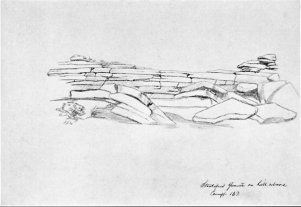
GRANITE FORMATION NEAR CAMP 168 From a sketch by Charles F. Hoffmann |
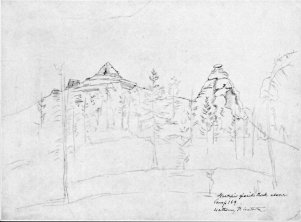
GRANITE FORMATION NEAR CAMP 169 From a sketch by Charles F. Hoffmann |
Now for the other tree. It is prostrate and no larger, but the story seems bigger. It has been burned out so that it is hollow, and we rode into it seventy-six feet and turned around easily. For forty feet three horsemen could ride in abreast, but we had but one horse along, which we took up on purpose to take this wonderful ride. Nor is it difficult, for most of the cavity is nine feet high and as wide. The greatest width is 11 feet 6 inches, and the greatest height is 11 feet 8 inches in the clear. Our horse was very gentle, and in this part I stood erect in the saddle and could just fairly reach the top! The tree is broken in two places, and fire has widened the fracture. At 120 feet from the base the tree is still 13 feet 2 inches in diameter inside of bark, and at 169 feet it is still 9 feet in diameter inside of the bark! All of these measurements were carefully made with an accurate tape line, except the height of the largest tree, which was got by measuring a base and triangulating.
There are trees of this species of every size, many being over twelve feet in diameter. Two of the smaller ones have been cut and split into fence posts—how it takes away the romance of them, using them for fence posts—and in a few years more many of the smaller ones will be sawn into lumber by the mill here!
About six miles east of this is a high bald mountain, about eight thousand feet, which we ascended, and a description of the view will answer for any of the higher points near. It commands a view of the whole western slope of the Sierra, the snowy peaks on one side, the great plain on the other.
Along the crest, twenty-five miles east, are the rugged snow-covered peaks that we hope to explore. The western slope is rough in the extreme, and both the topography and aspect are unlike anything else I have seen. The region is so very rough that I am filled with anxiety as to the possibility of reaching it. On the west the great plain stretches away to the horizon, the Coast Range being shut out by the hazy hot air that hovers over it.
NOTES
1. There are no letters in 1864 prior to this date. Brewer’s notebooks indicate that he was in San Francisco from January to May.
2. Meaning Pike County, Missouri. Richard D. Cotter went to Alaska after his season with the Whitney Survey, suffered a severe illness, and later settled in Montana. He wrote to Professor Brewer from time to time between 1870 and 1898. In a letter from York, Lewis and Clark County, Montana, September 18, 1898, he says: “I have been a J.P., Post Master, & the last office I was honored with was Sabbath School Supt. I imagine I can see you laughing as I have often seen in Camp. Of course I had other work to do or I should have starved to death long ago.” The correspondence indicates that he was miner, rancher, carpenter, and Jack-of-all-trades.
3. The mill was built by Joseph H. Thomas. It was situated a short distance west of the present General Grant National Park. The big trees described are in or near the park.
| Next: Chapter 2 • Contents • Previous: Book 4 |
| Online Library: | Title | Author | California | Geology | History | Indians | Muir | Mountaineering | Nature | Management |
http://www.yosemite.ca.us/library/up_and_down_california/5-1.html